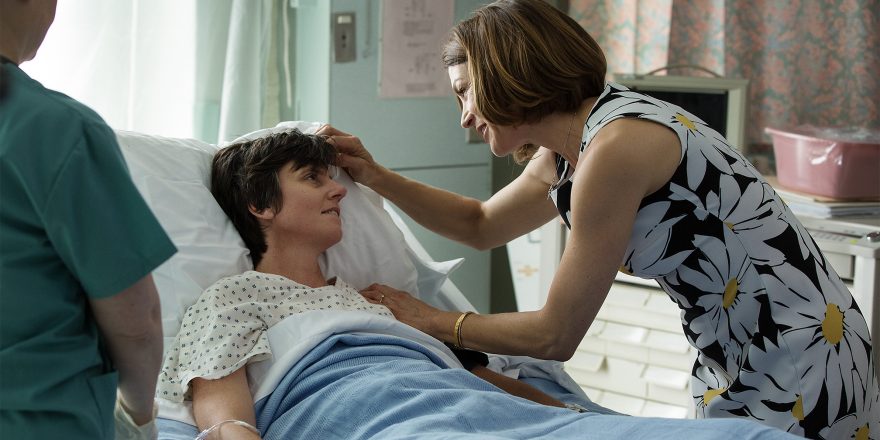Sitcoms revolving around stand-up comedians have been a television staple since the early 1970s, but I’ve never seen one quite like Tig Notaro’s One Mississippi. An Amazon series created by Notaro and screenwriter Diablo Cody, it superficially follows the same format as Sanford and Son, Seinfeld, Roseanne and Louie, fusing the contents of its star’s life and stage act with a 30-minute structure in which the elements of the comic’s monologues are transformed into an ensemble narrative – deepening and expanding upon the comic’s persona when it works (as in Louie), flattening the comedy out when it doesn’t (the ill-fated Andrew Dice Clay vehicle Bless This House). One Mississippi works and then some; like Louie, it goes so far beyond the normal boundaries of the comedian-based situation comedy template that it starts to feel like something completely different – something groundbreaking, exciting and challenging.
Louie’s Louis CK serves as an executive producer on One Mississippi, and he’s just one of several extremely talented artists involved with the show – in fact, one of the most interesting things about it is how it seems able to accommodate so many strong and singular voices without diluting any of them. The key voice, of course, belongs to star Notaro, whose recent biography also serves as exposition for the series: in 2012, she learned she had cancer (a discovery made famous in an off-the-cuff stand-up set at Largo), suffered through pneumonia and a potentially fatal intestinal infection, and underwent a double mastectomy – and her mother died from a bizarre accident that sent her into a coma. On One Mississippi, this is essentially the backstory for Notaro’s character (also named Tig), who returns to her hometown just in time to take her mother off of life support. She then stays in town longer than she had planned, reconnecting with her stepfather (John Rothman) and brother (Noah Harpster) and dredging up a lot of complicated memories and feelings – feelings that become even more complicated when she makes some surprising discoveries about her mom’s secret life.
This is pretty dark stuff for a comedy, and tonally One Mississippi doesn’t resemble any of its antecedents in the world of stand-up-driven TV series – it’s about as far from Everybody Loves Raymond as Risky Business is from Porky’s. Much as Risky Business writer-director Paul Brickman took the raw materials of the teen sex comedy and subverted and reinvented them to create a hallucinatory commentary on the corrupt values the genre celebrated, Notaro, Cody and show-runner Kate Robin have transformed the glibly amusing conventions of the sitcom into a touching and occasionally harrowing – and often very funny – meditation on the thin line between comedy and tragedy. The scene in which Tig and her family take Tig’s mom off of life support is a case in point: it’s the kind of thing we’ve seen in other shows and movies (though not necessarily comedies), but never in the way that it’s presented here.
Once the machines are shut off, Tig’s mom takes a long time to actually die, and Nicole Holofcener – the director of the show’s first three episodes – brilliantly paces the scene out in virtually real time. The duration itself inspires a wide variety of reactions in the viewer, as the situation goes from sad to ridiculous to angering to amusing and back to sad again, and it forges identification with Tig’s character in a manner more profound and irrevocable than one usually finds in even the best TV series and films. That identification yields many rewards over the course of the series, particularly when it comes to the revelations that Tig has about her mother’s past life – again, even though we’ve seen this kind of stuff before, it carries a comic and dramatic weight in One Mississippi that’s unique to the series. Tig is a strong, self-aware character, but she has her blind spots, and these blind spots are where the show finds some of its most effective moments. The stepfather character is particularly well drawn in this sense; as played by John Rothman, he starts off seeming like a caricature but slowly and steadily reveals layer after layer, so that by the end of the season it becomes clear that his inner life is every bit as rich and painful as Tig’s. In so many TV comedies, the characters become jokes – here the jokes become characters.
This kind of delicate dramedy is the kind of thing Holofcener specializes in – has there ever been a movie more simultaneously hilarious and painful than Lovely and Amazing? – and her direction of the first half of the six-episode first season is unerring in its awareness of when to go for laughs and when to let the tragedy just play as tragedy. The tonal shifts become even more pronounced – and more powerful – in episodes 4 and 5, both of which are exquisitely directed by Ken Kwapis. The subject matter in these episodes veers from the absurd (Tig taking her mom’s place as a “Mardi Gras Queen” in a local parade) to the awkward (Tig’s Civil War re-enactor brother botching two separate would-be romances) to a remarkable scene that is simultaneously sexy, sweet, nervous and funny (Tig exposing her scarred chest to a new lover just before they make out). Kwapis has previously shown he’s adept at this kind of tonal juggling – last year’s A Walk in the Woods was a virtual master class in balancing broad comedy and poignancy – but he’s never been called upon to synthesize such disparate moods in so compact a time frame. He and Holofcener lay the groundwork for the season’s final episode directed by Shira Piven, which beautifully weaves together the various plot strands of the series for a deeply affecting but understated finale.
These directors – and writers Cody, Robin, Stephanie Allynne, Melissa Blake, Cara DiPaolo and Robbie Pickering – are tuned into Notaro’s frequency in a way that is truly awe-inspiring given how unusual and specific her voice is. Her comedy is confessional but not indulgent or navel-gazing; both on stage and in this series, it’s the ultimate example of the personal becoming universal. I’m not sure how she pulled together so many people who are great, distinctive filmmakers in their own right (Cody, Holofcener, Kwapis, Louis CK) and retained and utilized their specificity in the service of her own, but the production of the series seems to have perfectly informed the material itself: the show couldn’t be more focused in its tragicomic intensity, yet makes room for so many rich digressions and complicating perspectives that it achieves a depth and texture uncommon in any medium. That Notaro does all of this in a package running under three hours is all the more impressive; that she does it in a genre often used as little more than a delivery system for one-liners and put-downs is borderline miraculous.






